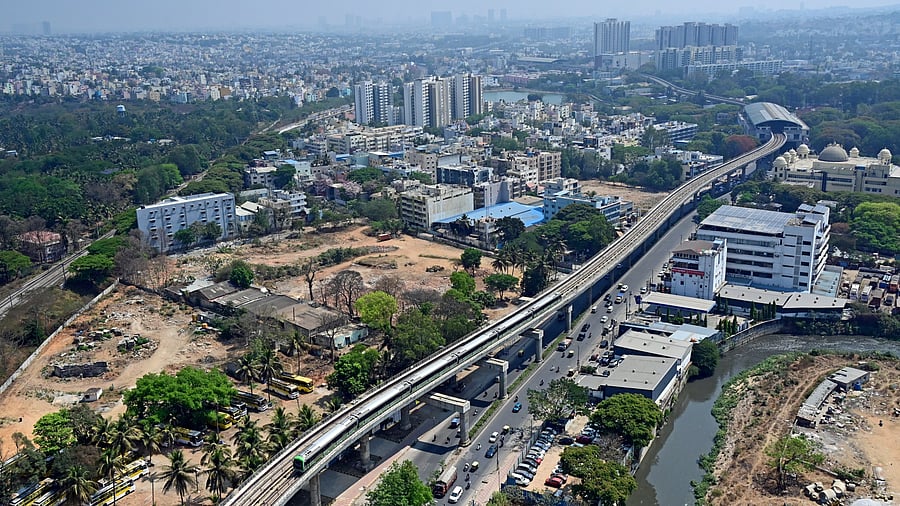
The GBG Bill of 2024 proposes the creation of no more than seven city corporations along with an apex body called the Greater Bengaluru Authority.
Credit: DH File Photo
Bengaluru contributes nearly 40% to Karnataka’s gross domestic product and is home to about 15 million people, including a vibrant community of entrepreneurs and highly skilled professionals. Yet, the city is plagued by unplanned development, water shortages, congested roads, overstretched public transport, and worsening air quality. These challenges are not unique to Bengaluru but are shared by many of India’s fast-growing metro cities.
From just five in 1951, India grew to 53 metropolitan cities by 2011, each with populations exceeding one million and together accounting for 36% of the urban population. The six largest — Mumbai, Delhi, Bengaluru, Chennai, Hyderabad, and Kolkata — are estimated to contribute over 20% to the country’s GDP. By 2030, India is projected to have 71 metropolitan cities. Yet, it still lacks a coherent national model tailored to the complex challenges of these large agglomerations and enabling them to reach their full potential.
Currently, governance structures for metros are virtually indistinguishable from those of smaller towns, over 3,500 of which have populations below 100,000. The 74th Constitutional Amendment Act of 1992, which defines the decentralised urban governance framework, makes no distinction between large and small cities, except
for calling for the formation of Metropolitan Planning Committees (MPCs) and District Planning Committees (DPCs) for regional coordination.
In the absence of a model metropolitan framework from the union government, states have pursued their own varied paths. Delhi split into three municipal corporations in 2012, only to reunify them in 2022. Mumbai, Chennai, Hyderabad, and Kolkata have a central municipal corporation surrounded by smaller ones.
Bengaluru’s latest experiment in metropolitan governance is the Greater Bengaluru Governance (GBG) Act, 2024. The Act marks another twist in the city’s governance journey by calling for the creation of a Greater Bengaluru Authority (GBA). In 2007, the state government created the Bruhat Bengaluru Mahanagara Palike (BBMP) by merging the erstwhile Bengaluru Mahanagara Palike (BMP) with eight smaller municipalities and over 100 villages. A second overhaul within two decades reflects the absence of long-term vision and stakeholder consensus to manage Bengaluru’s growth.
Beyond the debate over single versus multiple corporations under a metropolitan authority, India’s metros suffer from systemic issues: the absence of integrated long-term socio-economic and spatial planning; decision-making dominated by MLAs and bureaucracy; fragmented service delivery accountability between municipalities; and state-controlled parastatals. These challenges are compounded by longstanding issues plaguing all urban local governments: delayed elections, short mayoral tenures, inadequate devolution of powers, poor inter-agency coordination, and weak citizen engagement. State departments often overshadow elected municipal councils, rendering them powerless. These institutional weaknesses result in duplication of efforts, inefficient resource use, blurred accountability, and chronic delays in infrastructure delivery — all of which undermine ease of living and doing business.
The GBG Act proposes dividing the Greater Bengaluru area into up to seven municipal corporations, with 500 to 1,000 councillors depending on the final configuration. The government argues this will deepen decentralisation. To its credit,
the Act establishes the GBA for integrated regional planning and coordination and creates a unified municipal cadre across the GBA.
However, serious gaps remain. The Act does not empower the State Election Commission (SEC) with ward delimitation and reservation powers — key reasons for delays in municipal elections. Mayors are given a term of just 30 months instead of five years, limiting their ability to implement a strategic vision. There is no mayor-in-council system akin to cabinet government. The GBA is headed not by an elected metropolitan mayor but by the chief minister, raising concerns about continued state government dominance and weakened decentralisation.
Municipal councils lack the authority to approve budgets or appoint senior staff. There are no provisions for hiring specialists through lateral entry, auditing internal controls, or appointing an ombudsman for grievance redressal.
Despite claiming to prioritise citizen participation, the Act eliminates Area Sabhas — grassroots forums for residents to engage in planning and seek grievance redressal. Ward Committee decisions remain only advisory. Further, the creation of Assembly Constituency-level Coordination Committees headed by MLAs undermines the role of elected councillors and ward committees.
The progressive recommendations of the government’s own Brand Bengaluru Committee — grounded in extensive research and public consultation — had raised high expectations that faded quickly. The latest restructuring under the GBG Act is, at best, a fig leaf for the robust metropolitan governance that Bengaluru and other Indian metros truly deserve. It creates an appearance of reform without addressing deeper structural deficits in democratic devolution, institutional coordination, public accountability, and community participation.
Still, by taking the significant step to reframe its urban governance architecture, Bengaluru remains ahead of its peer metros, which have yet to address similar issues meaningfully. If treated not as an endpoint but as a continuation of the reform process, the GBG Act could serve as a stepping stone toward more substantive and meaningful reforms in the near future.
(The writer is Head, Participatory Governance at Janaagraha Centre for
Citizenship and Democracy)